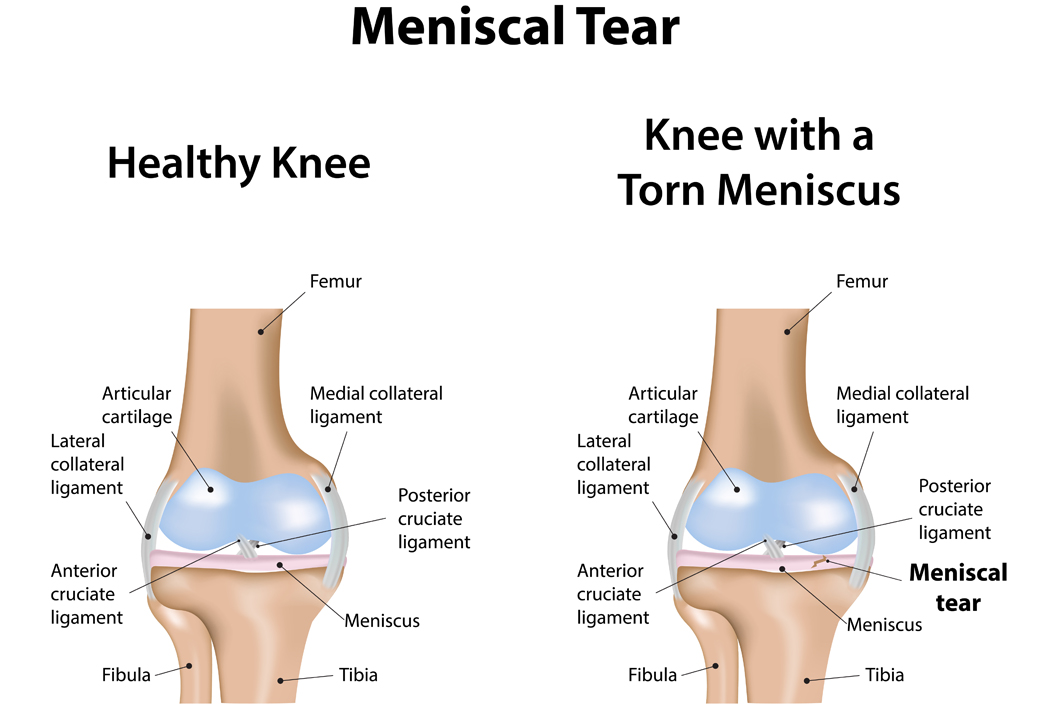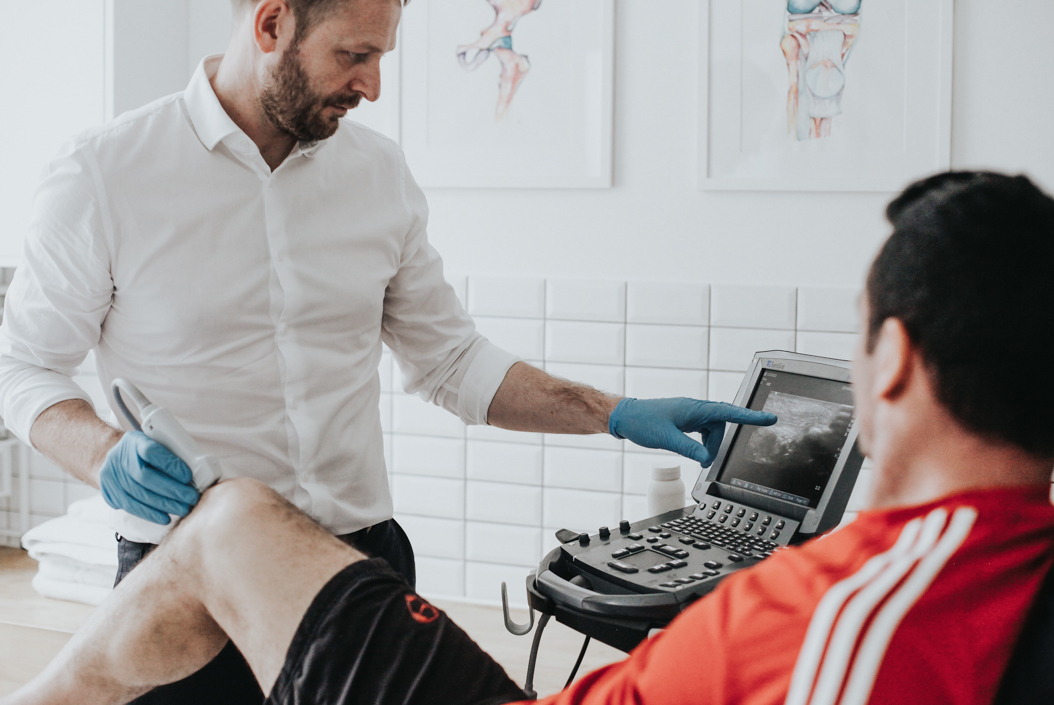What is A Meniscal tear?
What is cartilage?
Cartilage is a very strong, smooth, elastic, fibrous structure found in joints and at the end of long bones. In the body it takes many forms and has multiple purposes throughout the body.
In the knee we have two types of cartilage; articular cartilage and the menisci cartilage.
The articular cartilage is located on the end of the bones; the femur (above the knee) and tibia (below the knee). Articular cartilage is involved in osteoarthritis.
The menisci are situated in between the bones, on top or below the articular cartilage, they are not connected to the articular cartilage.
For this article we are going to solely focus on menisci cartilage.
What is the function of meniscus?
The menisci are a fibrocartilaginous structure that provide the joint with increased stability, distributes body weight evenly through the knee and increases shock absorption.
There are two menisci. The one on the outside, also known as the lateral meniscus and the one on the inside, known as the medial meniscus (see image below). The medial meniscus is the most commonly injured of the two.
Each meniscus has an anterior and posterior horn and most tears occur at the posterior horn.
A torn meniscus is a common injury that can affect active and sedentary patients of all ages.

How do you tear the meniscus?
The meniscus is most commonly injured by a twisting or turning movement whilst your foot is planted on the floor. In a young sporty person this could be due to turning quickly when playing a game of football or a tackle during a rugby match.
The effect of this twisting movement puts torsion throughout the meniscus and causes the fibres to tear. This results in an acute tear of the meniscus. Some people report they hear their knee click and feel pain immediately.
There are many different types of tears (see image below). The different tears can present with their own specific symptoms. For example, a ‘bucket handle tear’ may cause ‘locking’ of the knee. ‘Locking’ is when the knee gets stuck in one position and you cannot move it. This is very painful and debilitating when it happens. Not everyone with this type of tear experiences this problem.

As we get older meniscal tears can occur with the same twisting mechanism but they can also occur due to seemingly innocuous movements such as misjudging a step or turning whilst walking. It is not unusual that there is no specific incident or trauma, before the knee becomes painful.
How do you know if you have a meniscal tear?
The symptoms can vary from person to person but the key signs and symptoms are:
- Swelling – this normally takes 24 hours to develop after the onset of pain or injury
- Tenderness on the inside (medial meniscus tear) or outside (lateral meniscus tear) of the knee
- Pain with straightening the knee
- Pain and an inability to bend the knee fully i.e. unable to pull your heel into your buttock
- ‘Locking’ and ‘clunking’ of the knee
- Pain whilst squatting, twisting and kneeling

How is a meniscal tear diagnosed?
Meniscal tears are quite straightforward to diagnose. Clinical assessment has been shown to be around 80% accurate for diagnosis of meniscus tears. Your physiotherapist will carry out specific clinical tests to assess for tenderness on the joint line (where the meniscus is located), your range of movement, the amount of swelling in your joint and the stability of your knee. There is a specific meniscal test called the ‘McMurray’s test’ that your physiotherapist may additionally carry out to help establish your diagnosis.
If we are unsure of your diagnosis or we would like to understand more about the extent and type of the meniscal tear then we may refer you for an MRI scan. MRI scans are also very useful to assess for any other contributing factors such as an associated ligament tear. We can refer you directly without going to your GP.
At Complete Physio our highly experienced physiotherapists will comprehensively assess your knee joint using a series of clinical tests.
Some of our clinicians are also fully qualified musculoskeletal sonographers and will carry out a diagnostic ultrasound scan of your knee.
Ultrasound is unable to assess the deep portion of the meniscus, however, it is an effective tool to assess for any swelling and inflammation in the knee. Ultrasound can also visualise meniscal cysts and other structures in the knee such as the medial and lateral collateral ligaments and the surrounding tendons. Meniscal cysts are small fluid-filled pockets that arise from the meniscus. These can occur secondary to a tear.
There is no extra charge for an ultrasound scan.
Research has shown an increased risk of early onset of arthritis after damaging your meniscus and therefore an accurate diagnosis and appropriate treatment is paramount to a positive outcome (Kulkarni et al, 2014 ).

Will your meniscus heal?
This is not a simple yes or no answer! There are many factors that will determine whether a meniscal tear will heal or not. Age and location of the tear are two of the main variables. Even if the tear does heal it often takes months rather than weeks to recover. The blood supply to the meniscus is poor and so any healing is relatively slow, compared to a muscle for example, which has a rich blood supply.
The younger you are, the more likely it is to heal. Unfortunately over the age of 30, meniscus tears are far less likely to heal. The good news is most of these tears even though they do not heal, become pain free. This is supported by a significant body of evidence that patients with a meniscus tear in their knee observed on MRI, are often asymptomatic. Like many places in the body e.g. the lower back, there is a poor correlation between structural abnormalities and levels of pain.
The location of tear can influence whether a meniscal tear will heal or not. As mentioned earlier the menisci have a relatively poor blood supply. The blood supply varies depending on the location of the tear. It can be split into a white zone and a red zone (see image below). The red zone is located on the periphery (the outside) of the meniscus and has superior blood supply to the white zone, which is located in the deeper portion. If a tear is located in the red zone, they have more potential to heal. To determine exactly where your tear is located you would require an MRI scan.

How do you treat a torn meniscus?
Gaining a correct diagnosis is of paramount importance and is the first stage of getting back on the road to recovery. Your age, mechanism of injury, location, type and size of tear will influence which treatment is required. But it is not as simple as this, as patients can present very differently with the same injury.
At Complete Physio each patient is treated as an individual. Following a comprehensive assessment your physiotherapist will present the best treatment options available to you. Most clients we see with a meniscal tear do improve with a course of physiotherapy, surgery is rare.
The best solution for you will vary depending on your own individual circumstances. For example, a professional footballer is more likely to have surgery than a sedentary individual or recreational runner, as they do not have the time to ‘wait and see’ whether it heals and/or the pain resolves.
Physiotherapy
Most meniscal tears improve with time and physiotherapy. Physiotherapy will include load modification e.g. reducing your running and walking and reduction or avoidance of the movements and activities that make your pain or swelling worse.
This advice will also be accompanied with a comprehensive exercise programme. Exercises will focus on your quadriceps (the muscle on the front of your thigh) and hamstring (muscle on the back of your thigh) muscles. You may also receive exercises to target your calf, “core” and hip. These exercises may be a combination of home exercises and gym based exercises depending on your individual circumstances. The exercises will progressively improve the strength and stability around your knee.
Treatment may involve ‘hands-on’ treatment to the knee such as soft tissue technique, and joint mobilisation to the hip, knee and ankle to improve range of movement and pain. Some of our physiotherapists may use acupuncture as an adjunct as part of your treatment programme.

Here are a few simple tips you may like to try if you suspect you have a torn meniscus.
These tips will depend on how long you have had the injury and how much swelling there is. We would always advise you seek expert help if you have any concerns or your pain and swelling gets worse:
- Try applying an ice compress e.g. small packet of frozen peas, wrapped in a towel, on your knee for 10 minutes. This will help to reduce inflammation and pain. DO monitor your skin as you can burn yourself with ice.
- If you have significant swelling, we would advise you get a simple neoprene knee brace (image below right) or tubigrip. This will help reduce pain and swelling.
- Do not keep your knee in the same position for prolonged periods of time. If you sit at a desk all day make sure you regularly get up and move around. This will stop the knee stiffening up.
- Complete regular gentle knee stretches, within your available pain-free range. Make sure you are bending and straightening your knee. Keeping your knee still is generally not useful.
- Gentle quadriceps contractions (see image left below) will help to maintain some muscle strength. In sitting, slowly straighten your knee by squeezing your thigh. Complete the movement within your available pain-free range.

What if your knee pain is not improving?
If conservative treatment and options have been unsuccessful there are a few other treatment modalities available to you.
Ultrasound-Guided Injections.
At Complete Physio we have highly specialised physiotherapists who carry out ultrasound guided injections for meniscal injuries. There are two main options; steroid or hyaluronic acid injections.
Steroid injection
If pain persists then a steroid injection may be required. A mixture of local anaesthetic and corticosteroid (a potent anti-inflammatory) is injected under the guidance of a real time ultrasound scan. This is to ensure the affected area is accurately targeted. Research has shown that guided injections are more accurate and are more effective at reducing pain than non-guided injections.
Hyaluronic Acid injection
Hyaluronic acid is not a drug, it is classified as a medical devise. It has no side effects and is an alternative to steroid. It does have anti-inflammatory properties but is not a strong anti-inflammatory like steroid. It works by lubricating the knee joint and improving the shock absorbing properties of the joint. The products we use are called Ostenil Plus and Durolane. These have the highest molecular weight of hyaluronic acid on the market. They are both one off injections.

If you have been diagnosed with a meniscal cyst, an ultrasound guided aspiration and steroid injection can be an effective treatment option. This procedure involves ‘sucking’ the fluid out of the cyst and injecting steroid to stop it returning.
Surgery
Ten years ago, if you had a confirmed meniscal tear on MRI and you were not improving after 6 weeks you may be offered an arthroscopy (keyhole surgery). However, there have been large studies published, with thousands of patients in, showing no difference in outcomes between those who had surgery and those who did not. Surgery should be considered if your knee has mechanical symptoms. Mechancial symptoms are defined as locking or clunking of the knee with a significant restriction in range of movement and pain.
Meniscal surgery is not recommended if you have underlying osteoarthritis as the research has shown poor outcomes. At this stage, the main focus is about managing the pain and undertaking regular physiotherapy. Pain management may include injection therapy, such as steroid, hyaluronic acid or Platelet Rich Plasma (PRP). If you would like to discuss these in more details please do not hesitate to contact us.
If you feel you require surgery or would like to consider the surgical options available you would need to be referred to an orthopaedic consultant. They may organise for further investigations and will discuss all surgical opinion. This can be arranged by your physiotherapist.
Complete has a team of highly experienced physiotherapists who are experts in the assessment and treatment of all knee joint issues. If you would like further information or to book an appointment please contact us on 0207 4823875 or email info@complete-physio.co.uk.

